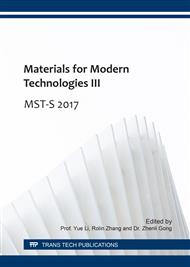p.128
p.134
p.141
p.148
p.155
p.162
p.167
p.175
p.182
The Effect of Regeneration Conditions on the Properties of CeO2 Desulfurization Sorbent in SO2 Atmosphere
Abstract:
CeO2 desulfurization sorbent was prepared by calcination of Ce(NO3)3 ● 6H2O and the effect of regeneration conditions on its properties in SO2 atmosphere was investigated in a fixed bed reactor. The regeneration conversion and the yield of elemental sulfur for CeO2 desulfurization sorbent were tested and calculated. And the composition and the morphology of CeO2 desulfurization sorbent before and after regeneration were obtained by X-ray diffraction and scanning electron microscope. It was found that the main components of the regeneration products of Ce2O desulfurization sorbent were solid CeO2 and gaseous elemental S in SO2 atmosphere. The optimum regeneration condition of CeO2 desulfurization sorbent is that the regeneration temperature of 750 °C and the SO2 concentration of 4.25 %, under which the CeO2 desulfurization sorbent shows the higher regeneration conversion of 96 % and the yield of elemental sulfur of 68.95 wt. %.
Info:
Periodical:
Pages:
155-161
Citation:
Online since:
March 2017
Authors:
Price:
Сopyright:
© 2017 Trans Tech Publications Ltd. All Rights Reserved
Share:
Citation:


